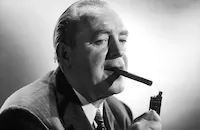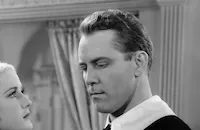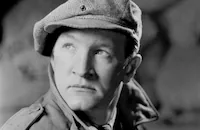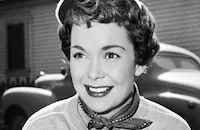Slim

Brief Synopsis
Cast & Crew
Ray Enright
Pat O'brien
Henry Fonda
Stuart Erwin
Margaret Lindsay
J. Farrell Macdonald
Film Details
Technical Specs

Synopsis
Farmboy Slim, fascinated by the high wire lineworkers near his farm, gets his chance to join them when a crewman is fired. Veteran lineman Red Blayd takes Slim in hand and he does well at his job, but both he and Red are fired when they loyally lie to protect their boss Pop Traver. Still, they have been well paid, so the two men take off together for Chicago where Red's girl Cally is a nurse. The three of them celebrate at nightclubs and expensive restaurants until their money runs out. Before Slim leaves with Red to find a new job, Cally begs him to quit this dangerous work before he is seriously hurt. Slim and Red sign on to a crew in the desert where Slim is seriously wounded when crewman Wilcox pulls a knife during a fight. Cally comes to nurse Slim and they fall in love. Slim and Cally tell Red that they want to get married, but Cally changes her mind when Slim turns down a desk job to work on the wires. Disappointed and angry, Slim heads back East with Red to join Pop's new crew. When some wires go down in a heavy storm the men must make repairs near exposed electrical wires. Cally braves the storm to follow them to the site and watches in horror as Red falls to his death. She hopes this will change Slim's mind about the work, but when he goes back up anyway, she tells him she'll be waiting when he comes down.

Director
Ray Enright
Cast

Pat O'brien

Henry Fonda

Stuart Erwin

Margaret Lindsay

J. Farrell Macdonald

Dick Purcell

Joseph Sawyer

Craig Reynolds

John Litel

Jane Wyman
Harlan Tucker
Joseph King
Carlyle Moore Jr.
James Robbins
Henry Otho
Dick Wessel
Max Wagner
Ben Hendricks
Alonzo Price
Maidel Turner

Walter Miller
Cliff Saum
Herbert Heywood

Tom Wilson
Douglas Williams
George Lloyd
Edwin Maxwell
Ferdinand Schumann-heink

Emmett Vogan
Davison Clark
Brenda Fowler

Edward Mcwade
Dorothy Vaughan
John Harron
Henry Otho
Wade Boteler
Crew
Sam Bischoff
Delmer Daves
Leo F. Forbstein
William Wister Haines
Byron Haskin
Sid Hickox
Lee Katz
Charles Kenyon
Gene Lewis
Owen Marks
Howard Shoup
Ted Smith
Jack L. Warner

Film Details
Technical Specs

Articles
Slim
The formula already had been established in films O'Brien made with James Cagney, and the plot of Slim is strikingly similar to Tiger Shark (1932), starring Edward G. Robinson as a tuna fisherman whose best friend falls for his girlfriend. But, in Slim, Fonda adds something new with the rough-hewn idealism that would find its most vivid expression three years later in The Grapes of Wrath (1940).
Enright's handling of the material impressed The New York Times critic Frank S. Nugent, who wrote, "The very romanticization of the genus lineman raises Slim above mere melodramatic classification. For the picture does grope toward the major truth that there is a nobility inherent in labor from which sparks may be struck and take lodging in the soul of even an ordinary little man. The narrative flashes along dramatically, treating in a series of heart-pounding sequences the successive stages of the lad's apprenticeship, his first trip up a skeleton steel tower, his increased mastery of the rueful art of defying the laws of gravity, and building tensely to a tragic and somehow inspiring climax."
Jane Wyman, near the beginning of her 10-year Warner Bros. apprenticeship, was still considered "window dressing" by the studio at the time of Slim. Her breakthrough role as a dramatic actress came at Paramount in The Lost Weekend (1945), but she would return to Warners in triumph with her Oscar-winning role in Johnny Belinda (1948). Enright directed Wyman in five other films, but Slim marked the only occasion in which Wyman and Fonda, who would surely have made a winning co-starring team, appeared in the same movie.
Producer: Hal B. Wallis
Director: Ray Enright
Screenplay: William Wister Haines
Art Direction: Ted Smith
Cinematography: Sidney Hickox
Costume Design: Howard Shoup
Editing: Owen Marks
Original Music: Max Steiner
Principal Cast: Pat O'Brien (Red Blayd), Henry Fonda (Slim), Stuart Erwin (Stumpy), Margaret Lindsay (Cally), J. Farrell MacDonald (Pop), Dick Purcell (Tom), Jane Wyman (Stumpy's Girl).
BW-86m. Close captioning
. by Roger Fristoe

Slim
Quotes
Who do we notify if you break the law?- Man
Break what law?- Slim Kincaid
The law of gravity. Who do we notify if you fall off a tower?- Man
Notify the guy that's underneath me to get out of the way.- Slim Kincaid
How come they asked him to be a boss and he won't?- Slim Kincaid
How come anything about Red? He does what he wants to do, not what other people want. Nobody knows where he come from or where he's going to. But any outfit in the country would want old Red to work for them.- Clarence 'Stumpy' Stump
That's what's the matter.- Slim Kincaid
I always said a lineman was nothing but a grunt that lost his good sense, and now you gone and done it.- Clarence 'Stumpy' Stump
Trivia
Notes
Hollywood Reporter notes that the film took 44 days to shoot. The movie opens with shots of Boulder Dam (which was renamed Hoover Dam in 1947) in Nevada.















